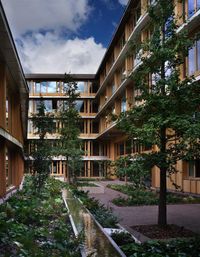On a crisp October evening in 2025, the architectural world gathered at the Roundhouse in London to witness the unveiling of this year’s Royal Institute of British Architects’ (RIBA) Stirling Prize winner. Amid stiff competition from iconic restorations and innovative new builds, it was the Appleby Blue Almshouse in Bermondsey, south London, that took home the top honor, cementing its place as Britain’s best new building.
Appleby Blue Almshouse, designed by Witherford Watson Mann and commissioned by United St Saviour’s Charity, is more than just a collection of bricks and mortar. It’s a bold, modern answer to the age-old tradition of almshouses, built specifically to combat loneliness and provide affordable, high-quality homes for people over the age of 65. The project stands as a testament to the transformative power of architecture—one that doesn’t just shelter, but actively nurtures community and well-being.
Spread across five thoughtfully designed floors, Appleby Blue offers 59 spacious flats, each benefiting from an abundance of natural light and generous proportions. But what truly sets this development apart are its communal facilities: a vibrant roof garden, a lush courtyard, a civic room, and a welcoming community kitchen. These shared spaces aren’t just afterthoughts—they’re the heart of the building, designed to bring residents together and foster a sense of belonging that can be elusive in later life.
The judges were effusive in their praise. According to BBC, the Stirling Prize panel described Appleby Blue as “a provision of pure delight,” and said it “sets an ambitious standard for social housing among older people.” Ingrid Schroder, director of the Architectural Association School of Architecture and chair of the jury, went further, calling the project “a clarion call for a new form of housing at a pivotal moment.” She emphasized the building’s timely response to two pressing crises: an acute shortage of suitable housing and a growing epidemic of loneliness among older people. “Appleby Blue offers a hopeful and imaginative response, where residents and the surrounding community are brought together through the transformative nature of the design,” Schroder said.
The building’s character is evident from the moment one enters. Terracotta-paved hallways lined with benches and greenery invite lingering conversations. A tranquil water feature lends the air of a woodland oasis, offering a stark—and welcome—contrast to the institutional feel that so often plagues housing for older adults. As RIBA noted, these features together create “an aspirational living environment that stands in stark contrast to the institutional atmosphere often associated with older people’s housing.”
The almshouse stands on the site of a former care home, but its roots stretch much deeper. United St Saviour’s Charity, the organization behind the project, has been addressing social needs in the Southwark community for nearly 500 years. Their mission remains unchanged: to provide for those in need, particularly as they age. The charity subsidizes the flats, ensuring that even those on low incomes can access a dignified, supportive place to live out their later years. In the words of Stephen Witherford from Witherford Watson Mann, “Working closely and imaginatively with United St Saviour’s Charity, we’ve created an environment that reduces loneliness, encourages connection, and supports a good later life. The charity has made social housing aspirational, enabling people to grow old locally with the right support, benefiting both residents and the wider Southwark community. We’re honoured that the RIBA Stirling Prize recognises the power of architecture to create places that genuinely transform lives.”
Appleby Blue’s win is all the more impressive given the caliber of its competition. Among the finalists were the newly restored Elizabeth Tower—which houses the iconic Big Ben—London College of Fashion’s striking new campus in Stratford’s Olympic Park, a cutting-edge science laboratory, and the Japanese-inspired Niwa House in East Dulwich. Each of these projects brought something unique to the table, but it was Appleby Blue’s social mission and innovative design that ultimately swayed the judges.
This isn’t the first time Witherford Watson Mann has claimed the Stirling Prize. Twelve years ago, the firm was recognized for its groundbreaking modern holiday home inside the ancient Astley Castle in Warwickshire, a project that similarly blended history, community, and contemporary design. The architects’ repeat success speaks to their enduring commitment to creating spaces that are not just visually striking, but deeply human in their intent and execution.
The Stirling Prize itself is no ordinary accolade. Handed out annually by RIBA since 1996, it is considered one of the most prestigious awards in architecture. Each year, the prize is given to the building judged to have made the most significant contribution to the evolution of architecture and the built environment, with criteria spanning design vision, innovation, and originality. Past winners read like a who’s who of British design: Liverpool’s Everyman Theatre, Hastings Pier, the Scottish Parliament building in Edinburgh, and, just last year, the Elizabeth line—London’s east-west train line—were all previous recipients.
What makes Appleby Blue’s achievement especially notable is its focus on a demographic often overlooked in the world of high-profile architecture. While gleaming towers and cultural landmarks tend to dominate headlines, housing for older adults rarely gets the same attention. Yet, as the UK’s population ages and the challenges of loneliness and affordability grow ever more acute, projects like Appleby Blue are proving that thoughtful, community-focused design can have a profound impact.
As the sun set over Bermondsey on the night of the awards, residents of Appleby Blue could be seen tending to the communal garden, chatting on benches, and sharing meals in the community kitchen. These everyday moments—simple, yet full of meaning—are what the architects and charity set out to create. And as the Stirling Prize judges made clear, it’s these moments that represent the true evolution of architecture: buildings that don’t just stand apart, but bring people together.
With its win, Appleby Blue Almshouse has set a new benchmark for what social housing can—and should—be. It’s a reminder that great architecture isn’t just about what we see, but how we live, connect, and care for one another as we age.




